Pretty good article, although @gerryvz will need to proofread for accuracy. 
I didn't know it was actually a 6.8L engine. No wonder AMG badged the 6.2L M156 as E63, S63, etc. Because, one bigger! Hey, why wasn't the E60 badged E61?
The video (below) had some really neat archival footage of the R&D involved:

 www.gearpatrol.com
www.gearpatrol.com
This may look like the sort of old, ordinary, big-bodied Mercedes-Benz that your grandfather drove back in the day. But it isn’t (though it could be depending on how wealthy he was).
What this is, is one of the Three-Point Star’s most iconic automobiles and perhaps, one of the most iconic sedans of all time. Sure, it has a very humdrum and basic three-box body.
But under its unassuming sheetmetal lies the sort of engineering wizardry that allowed this German sled to take the title as the world’s fastest production sedan for several years in the 1970s.
 It’s always an occasion when a 6.9 this clean shows up for sale. BringATrailer
It’s always an occasion when a 6.9 this clean shows up for sale. BringATrailer
Such superlatives and claims to fame are often associated with high-dollar and flashy supercars. But that’s what made this vehicle, so remarkable.
 The 6.9 debuted in France in 1975 as a follow-up to the equally epic W109 300SEL 6.3.Mercedes-Benz
The 6.9 debuted in France in 1975 as a follow-up to the equally epic W109 300SEL 6.3.Mercedes-Benz
It was just 50 short years ago when Mercedes-Benz introduced the game-changing W116 450SEL 6.9 in Europe. Built as the top-spec variant of the era’s S-Class, it was the follow-up to the W109 300SEL 6.3 before it.
These badges might seem meaningless at first. But they were the designated signatures for cars that would not only further perpetuate Mercedes-Benz’s reputation for being purveyors of understated performance, innovation and engineering mastery.
 The W109 300SEL 6.3 briefly held the title for world’s fasted production vehicle. Mercedes-Benz
The W109 300SEL 6.3 briefly held the title for world’s fasted production vehicle. Mercedes-Benz
But more so, these two super sedans set new performance benchmarks for years to come, helping to define the automotive archetype of being “way ahead of their time.”
Take for instance, the 6.9’s M100 V8 engine, lifted from the flagship W100 600 limousine. To date, it remains the largest displacement production engine ever produced by Mercedes-Benz.
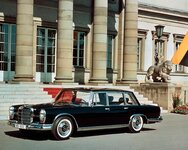 The W100 600 Pullman is one of Mercedes-Benz’s most iconic post-war models.Mercedes-Benz
The W100 600 Pullman is one of Mercedes-Benz’s most iconic post-war models.Mercedes-Benz
The 6.9 specifically was also the first production vehicle to feature modern electronically-controlled anti-lock brakes, compliments of Bosch.
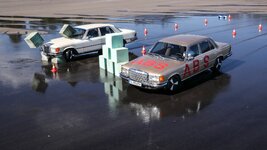 The W116 450SEL 6.9 was the first production vehicle to feature modern electronically-controlled ABS.Mercedes-Benz
The W116 450SEL 6.9 was the first production vehicle to feature modern electronically-controlled ABS.Mercedes-Benz
The 6.9 was so good, it dominated the headlines of nearly every automotive press outlet at the time. That included the late and epochal David E. Davis, the “father of automotive journalism” and founder of the now-defunct Automobile Magazine (which is also one of this writer’s former gigs).
 The late David E. Davis’ take on the 6.9 in CARandDRIVER is one of his and the publications most definitive pieces.BringATrailer
The late David E. Davis’ take on the 6.9 in CARandDRIVER is one of his and the publications most definitive pieces.BringATrailer
And even CARandDRIVER’s late Brock Yates had nothing but praise for the 6.9. One of Yates’ most iconic evaluations involved taking a 6.9 press car from MBUSA’s old headquarters in Manhattan to Road Atlanta, all to subsequently lap it around the world-famous track for a day at nearly full force.
Yates later drove the car back to Manhattan the same day, having only needed to adjust the vehicle’s tire pressure — a feat never imagined as possible at the time. Especially for a big, ponderous luxury sedan with so much power under the hood.
 The late Brock Yates, who also held editorial positions at C/D, also helped notarize the 6.9’s credibility.Mercedes-Benz
The late Brock Yates, who also held editorial positions at C/D, also helped notarize the 6.9’s credibility.Mercedes-Benz
But how they achieved all of this is nothing short of remarkable.
 Very few cars in history scream, “move out of the way” in the rear-view mirror, as the W116 S-Class.Mercedes-Benz
Very few cars in history scream, “move out of the way” in the rear-view mirror, as the W116 S-Class.Mercedes-Benz
In the late 1960s, Benz’s chief engineer Erich Waxenberger teamed up with a Mr. Hans Werner-Aufrecht, the founder of AMG Motorenbau und Entwicklungsgesellschaft mbH. Waxenberger’s ultimatum was to fulfill his personal desires to compete in motorsports.
After the commercial success with the W109 300SEL 6.3, Waxenberger and Aufrecht began experimenting to one-up the previous model. So, they took the original M100, massaged the bore to displace 6.8 liters. Or from 386 cubic inches to 417, for us Yanks.
 The 6.9-liter M100 remains Mercedes-Benz’s largest production engine ever.Mercedes-Benz
The 6.9-liter M100 remains Mercedes-Benz’s largest production engine ever.Mercedes-Benz
They also reworked the engine’s intake for increased air flow and fitted a dry-sump lubrication system for racetrack duties. That dry-sump lubrication system was later adopted for the 6.9’s use to extend oil change intervals. It was also the only way to get the M100 to sizably fit under the W116’s slim, aerodynamically-minded forward compartment.
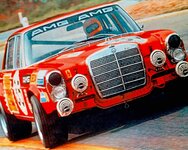 The iconic W109-based “Red Pig” served as the conceptual and developmental test bed for the W116’s 6.8-liter M100.Mercedes-Benz
The iconic W109-based “Red Pig” served as the conceptual and developmental test bed for the W116’s 6.8-liter M100.Mercedes-Benz
For initial testing, the duo fitted 6.8-liter prototypes into the body of Benz’s largest mass-production sedan at the time, the W109. The goal was to take the prototypes racing to see how they would perform.
The result was Mercedes-Benz’s “Red Pig,” an unconventional touring race car that competed among a sea of compact, lightweight and nimble sports cars.
Not only did the Red Pig go on to race at the world-famous 24 Hour of Spa-Francorchamps in 1971. It took second place overall behind a purpose-built, race-prepped Ford Capri.
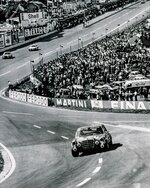 The “Red Pig” made headlines for its unconventional appearance at the 24 Hours of Spa-Francorchamps in 1971,Mercedes-Benz
The “Red Pig” made headlines for its unconventional appearance at the 24 Hours of Spa-Francorchamps in 1971,Mercedes-Benz
But what’s more impressive is how it also showcased reliability and durability during an era when such a thing was still a grave effort of much trial and head-scratching. It achieved that podium position without mechanical failure — an incredible feat, especially for a grueling endurance race.
 The “Red Pig” helped perpetuate Mercedes-Benz’s motorsports aspirations.Mercedes-Benz
The “Red Pig” helped perpetuate Mercedes-Benz’s motorsports aspirations.Mercedes-Benz
And they did it all in a platform designed and engineered to transport five passengers on intercity Autobahn sprints at top speed, all day, without fail, in the safest and most comfortable way possible. It was the purist antithesis to the compact sports race of the day.
Could you just imagine the sort of awe-inspiring scene of watching such a big, ponderous sedan, lapping one of the world’s most renowned touring car endurance races? It was probably like watching a cow outrun a cheetah.
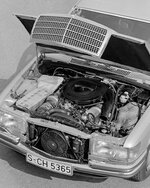 Euro-spec 6.9s produced 282 horsepower and a whopping 406 pound-feet of torque, but sadly, North American versions produced around 250 hp and and 360 lb-ft due to emissions compliance.
Euro-spec 6.9s produced 282 horsepower and a whopping 406 pound-feet of torque, but sadly, North American versions produced around 250 hp and and 360 lb-ft due to emissions compliance.
To continue the success of the 6.3, Waxenberger eventually slotted that motorsports-bred 6.8-liter M100 under the hood of the W116 S-Class (Europeans like to round-up numbers, which led to the 6.9 badge). And the results were just absolutely staggering.
Paired with a specially modified three-speed automatic, that 6.8-liter M100 enabled the 4,400-pound long-boi S-Class to sprint from 0 to 60 mph in just seven seconds and onto a top speed of over 140 MPH.
 The Euro 6.9 could sprint from 0-62 mph in just 7.4 seconds, which was unheard of for a full-size sedan during its heyday.Mercedes-Benz
The Euro 6.9 could sprint from 0-62 mph in just 7.4 seconds, which was unheard of for a full-size sedan during its heyday.Mercedes-Benz
Today, such numbers seem pedestrian. But for the era, the 6.9 blew the doors off of nearly every common sports car of the era. Regardless if it came from Italy or even Mercedes’ crosstown neighbors in Zuffenhausen.
That gave the 6.9 unprecendented bragging rights as the world’s fastest production sedan, both in acceleration and top speed. It would clutch those records until the 1980s.
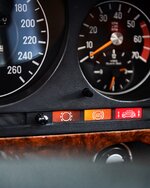 The 6.9 features four-corner hydropneumatic self-leveling suspension, which is the precursor to modern-day adaptive air suspension.Mercedes-Benz
The 6.9 features four-corner hydropneumatic self-leveling suspension, which is the precursor to modern-day adaptive air suspension.Mercedes-Benz
Complementing the wickedly powerful engine was a state-of-the-art four-corner hydropneumatic self-leveling suspension, adopted from Citroën. Mercedes-Benz engineers added a unique Watts linkage for the semi-trailing arm rear suspension, enabling anti-squat and progressive anti-dive geometry.
This prevented rear-end squatting under hard acceleration and front-end diving under hard braking. Such body control for a large vehicle was simply unheard of (watch the YouTube clip above, at 13:23, to see how flat the W116 remains under hard braking and acceleration compared to its predecessor).
 This impeccable example even comes with the original specification Michelin XWX high-performance rubber.BringATrailer
This impeccable example even comes with the original specification Michelin XWX high-performance rubber.BringATrailer
Combined with a short-ratio 2.75 lock-to-lock steering box, a limited-slip differential, and larger and more aggressive tires, the result was a nearly 17-foot-long hyper luxury sedan that handled with the athletic nimbleness and grace of an all-star running back.
The 6.9’s suspension technology laid the groundwork for what would later become Adaptive Damping System and Active Body Control.
 The only way to distinguish a 6.9 from the standard 450SEL, aside from popping the hood or looking for the suspension warning light and adjustment lever on the gauge cluster, was the trunk badge and its larger exhaust.Mercedes-Benz
The only way to distinguish a 6.9 from the standard 450SEL, aside from popping the hood or looking for the suspension warning light and adjustment lever on the gauge cluster, was the trunk badge and its larger exhaust.Mercedes-Benz
What added to the appeal of the 6.9 was the fact that it exerted all of this performance while also delivering the same signature comfortable, safe and solid experience as other Mercedes-Benzes. It was an absolutely shining example of cost-no-object, no-holds barred engineering, with fastidious attention to detail and unrivaled build quality.
 This specific 6.9 was once a former Cannonball Run podium winner for the 1979 event placing second overall.BringATrailer
This specific 6.9 was once a former Cannonball Run podium winner for the 1979 event placing second overall.BringATrailer
Most of all, it achieved these feats against all odds during the 1973 global oil crisis. Not only did the oil and gas shortage trigger the then-newfound concern for fuel efficiency and environmental conservation.
Safety also took a new precedent, leading some to believe such performance vehicles were going to meet their eventual demise from increasing regulation.
 This 6.9 on BaT is about as original and pristing as they come.BringATrailer
This 6.9 on BaT is about as original and pristing as they come.BringATrailer
That’s on top of the fact that the 6.9 cost nearly $40,000 in America, which was enough to buy a very, very nice house. That translates to about $222,000 with today’s conversion rates.
 The W116’s profile from nearly every angle remains subtly distinctive and eye-catching, just like it was in the 1970s.BringATrailer
The W116’s profile from nearly every angle remains subtly distinctive and eye-catching, just like it was in the 1970s.BringATrailer
Because of how capable it was, the 6.9 became an instant hit among Cannonball runners. Conceived by the same aforementioned Brock Yates, the Cannonball Run is the most famous unofficial race in the world: a speed trial against time to travel from coast-to-coast in the continental US in the fastest interval possible.
Such a competition requires a fast and comfortable vehicle, which the 6.9 delivered in spades. Especially when the Cannonball was at its peak in the 1970s.
 This specific 6.9 for sale features rare and hugely desirable Euro-specification single-lens headlights.BringATrailer
This specific 6.9 for sale features rare and hugely desirable Euro-specification single-lens headlights.BringATrailer
This specific 6.9 happens to be one of the Cannonball icons. Once owned by Dick Field, he and two other drivers went on to take second place during the 1979 event.
Field then reportedly held onto the car until about 2013, when it underwent a full restoration. It later changed hands several times, until landing once again on BringATrailer to find another collector.
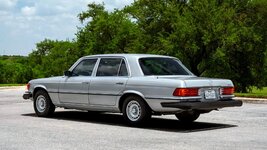 Despite the Euro headlights, this 6.9 still sports its North American-spec 5-mph “diving board” bumpers.BringATrailer
Despite the Euro headlights, this 6.9 still sports its North American-spec 5-mph “diving board” bumpers.BringATrailer
Having just traveled 46,000 miles on the analog odometer, this low-mileage example is a 6.9 that’s not only well-preserved. But also has a ton of history associated with it.
On top of being an actual Cannonball icon, this 6.9 will certainly be the source of much joy for the next owner who can appreciate every historical aspect of it. And what they’d be getting is simply one of the greatest automobiles ever made.
I didn't know it was actually a 6.8L engine. No wonder AMG badged the 6.2L M156 as E63, S63, etc. Because, one bigger! Hey, why wasn't the E60 badged E61?
The video (below) had some really neat archival footage of the R&D involved:
This Immaculate Vintage Mercedes Q-Ship Reminds Us Why It’s One of Benz’s Coolest Cars In the Past 50 Years
They didn’t call it the “banker’s hot-rod” for no reason.
This Immaculate Vintage Mercedes Q-Ship Reminds Us Why It's One of Benz's Coolest Cars In the Past 50 Years
One of Mercedes-Benz's most iconic cars turns 50 years old this year and we look back at the "banker's hot rod's" claims to fame.
This may look like the sort of old, ordinary, big-bodied Mercedes-Benz that your grandfather drove back in the day. But it isn’t (though it could be depending on how wealthy he was).
What this is, is one of the Three-Point Star’s most iconic automobiles and perhaps, one of the most iconic sedans of all time. Sure, it has a very humdrum and basic three-box body.
But under its unassuming sheetmetal lies the sort of engineering wizardry that allowed this German sled to take the title as the world’s fastest production sedan for several years in the 1970s.
 It’s always an occasion when a 6.9 this clean shows up for sale. BringATrailer
It’s always an occasion when a 6.9 this clean shows up for sale. BringATrailerSuch superlatives and claims to fame are often associated with high-dollar and flashy supercars. But that’s what made this vehicle, so remarkable.
The “father of automotive journalism” once called the 6.9 “the greatest Mercedes-Benz ever built”
 The 6.9 debuted in France in 1975 as a follow-up to the equally epic W109 300SEL 6.3.Mercedes-Benz
The 6.9 debuted in France in 1975 as a follow-up to the equally epic W109 300SEL 6.3.Mercedes-BenzIt was just 50 short years ago when Mercedes-Benz introduced the game-changing W116 450SEL 6.9 in Europe. Built as the top-spec variant of the era’s S-Class, it was the follow-up to the W109 300SEL 6.3 before it.
These badges might seem meaningless at first. But they were the designated signatures for cars that would not only further perpetuate Mercedes-Benz’s reputation for being purveyors of understated performance, innovation and engineering mastery.
 The W109 300SEL 6.3 briefly held the title for world’s fasted production vehicle. Mercedes-Benz
The W109 300SEL 6.3 briefly held the title for world’s fasted production vehicle. Mercedes-BenzBut more so, these two super sedans set new performance benchmarks for years to come, helping to define the automotive archetype of being “way ahead of their time.”
Take for instance, the 6.9’s M100 V8 engine, lifted from the flagship W100 600 limousine. To date, it remains the largest displacement production engine ever produced by Mercedes-Benz.
 The W100 600 Pullman is one of Mercedes-Benz’s most iconic post-war models.Mercedes-Benz
The W100 600 Pullman is one of Mercedes-Benz’s most iconic post-war models.Mercedes-BenzThe 6.9 specifically was also the first production vehicle to feature modern electronically-controlled anti-lock brakes, compliments of Bosch.
 The W116 450SEL 6.9 was the first production vehicle to feature modern electronically-controlled ABS.Mercedes-Benz
The W116 450SEL 6.9 was the first production vehicle to feature modern electronically-controlled ABS.Mercedes-BenzThe 6.9 was so good, it dominated the headlines of nearly every automotive press outlet at the time. That included the late and epochal David E. Davis, the “father of automotive journalism” and founder of the now-defunct Automobile Magazine (which is also one of this writer’s former gigs).
 The late David E. Davis’ take on the 6.9 in CARandDRIVER is one of his and the publications most definitive pieces.BringATrailer
The late David E. Davis’ take on the 6.9 in CARandDRIVER is one of his and the publications most definitive pieces.BringATrailerAnd even CARandDRIVER’s late Brock Yates had nothing but praise for the 6.9. One of Yates’ most iconic evaluations involved taking a 6.9 press car from MBUSA’s old headquarters in Manhattan to Road Atlanta, all to subsequently lap it around the world-famous track for a day at nearly full force.
Yates later drove the car back to Manhattan the same day, having only needed to adjust the vehicle’s tire pressure — a feat never imagined as possible at the time. Especially for a big, ponderous luxury sedan with so much power under the hood.
 The late Brock Yates, who also held editorial positions at C/D, also helped notarize the 6.9’s credibility.Mercedes-Benz
The late Brock Yates, who also held editorial positions at C/D, also helped notarize the 6.9’s credibility.Mercedes-BenzBut how they achieved all of this is nothing short of remarkable.
The 6.9 is a significant precursor to everything Mercedes-AMG stands for, today
 Very few cars in history scream, “move out of the way” in the rear-view mirror, as the W116 S-Class.Mercedes-Benz
Very few cars in history scream, “move out of the way” in the rear-view mirror, as the W116 S-Class.Mercedes-BenzIn the late 1960s, Benz’s chief engineer Erich Waxenberger teamed up with a Mr. Hans Werner-Aufrecht, the founder of AMG Motorenbau und Entwicklungsgesellschaft mbH. Waxenberger’s ultimatum was to fulfill his personal desires to compete in motorsports.
After the commercial success with the W109 300SEL 6.3, Waxenberger and Aufrecht began experimenting to one-up the previous model. So, they took the original M100, massaged the bore to displace 6.8 liters. Or from 386 cubic inches to 417, for us Yanks.
 The 6.9-liter M100 remains Mercedes-Benz’s largest production engine ever.Mercedes-Benz
The 6.9-liter M100 remains Mercedes-Benz’s largest production engine ever.Mercedes-BenzThey also reworked the engine’s intake for increased air flow and fitted a dry-sump lubrication system for racetrack duties. That dry-sump lubrication system was later adopted for the 6.9’s use to extend oil change intervals. It was also the only way to get the M100 to sizably fit under the W116’s slim, aerodynamically-minded forward compartment.
 The iconic W109-based “Red Pig” served as the conceptual and developmental test bed for the W116’s 6.8-liter M100.Mercedes-Benz
The iconic W109-based “Red Pig” served as the conceptual and developmental test bed for the W116’s 6.8-liter M100.Mercedes-BenzFor initial testing, the duo fitted 6.8-liter prototypes into the body of Benz’s largest mass-production sedan at the time, the W109. The goal was to take the prototypes racing to see how they would perform.
The result was Mercedes-Benz’s “Red Pig,” an unconventional touring race car that competed among a sea of compact, lightweight and nimble sports cars.
Not only did the Red Pig go on to race at the world-famous 24 Hour of Spa-Francorchamps in 1971. It took second place overall behind a purpose-built, race-prepped Ford Capri.
 The “Red Pig” made headlines for its unconventional appearance at the 24 Hours of Spa-Francorchamps in 1971,Mercedes-Benz
The “Red Pig” made headlines for its unconventional appearance at the 24 Hours of Spa-Francorchamps in 1971,Mercedes-BenzBut what’s more impressive is how it also showcased reliability and durability during an era when such a thing was still a grave effort of much trial and head-scratching. It achieved that podium position without mechanical failure — an incredible feat, especially for a grueling endurance race.
 The “Red Pig” helped perpetuate Mercedes-Benz’s motorsports aspirations.Mercedes-Benz
The “Red Pig” helped perpetuate Mercedes-Benz’s motorsports aspirations.Mercedes-BenzAnd they did it all in a platform designed and engineered to transport five passengers on intercity Autobahn sprints at top speed, all day, without fail, in the safest and most comfortable way possible. It was the purist antithesis to the compact sports race of the day.
Could you just imagine the sort of awe-inspiring scene of watching such a big, ponderous sedan, lapping one of the world’s most renowned touring car endurance races? It was probably like watching a cow outrun a cheetah.
The 6.9 was once the world’s fastest production sedan
 Euro-spec 6.9s produced 282 horsepower and a whopping 406 pound-feet of torque, but sadly, North American versions produced around 250 hp and and 360 lb-ft due to emissions compliance.
Euro-spec 6.9s produced 282 horsepower and a whopping 406 pound-feet of torque, but sadly, North American versions produced around 250 hp and and 360 lb-ft due to emissions compliance.To continue the success of the 6.3, Waxenberger eventually slotted that motorsports-bred 6.8-liter M100 under the hood of the W116 S-Class (Europeans like to round-up numbers, which led to the 6.9 badge). And the results were just absolutely staggering.
Paired with a specially modified three-speed automatic, that 6.8-liter M100 enabled the 4,400-pound long-boi S-Class to sprint from 0 to 60 mph in just seven seconds and onto a top speed of over 140 MPH.
 The Euro 6.9 could sprint from 0-62 mph in just 7.4 seconds, which was unheard of for a full-size sedan during its heyday.Mercedes-Benz
The Euro 6.9 could sprint from 0-62 mph in just 7.4 seconds, which was unheard of for a full-size sedan during its heyday.Mercedes-BenzToday, such numbers seem pedestrian. But for the era, the 6.9 blew the doors off of nearly every common sports car of the era. Regardless if it came from Italy or even Mercedes’ crosstown neighbors in Zuffenhausen.
That gave the 6.9 unprecendented bragging rights as the world’s fastest production sedan, both in acceleration and top speed. It would clutch those records until the 1980s.
 The 6.9 features four-corner hydropneumatic self-leveling suspension, which is the precursor to modern-day adaptive air suspension.Mercedes-Benz
The 6.9 features four-corner hydropneumatic self-leveling suspension, which is the precursor to modern-day adaptive air suspension.Mercedes-BenzComplementing the wickedly powerful engine was a state-of-the-art four-corner hydropneumatic self-leveling suspension, adopted from Citroën. Mercedes-Benz engineers added a unique Watts linkage for the semi-trailing arm rear suspension, enabling anti-squat and progressive anti-dive geometry.
This prevented rear-end squatting under hard acceleration and front-end diving under hard braking. Such body control for a large vehicle was simply unheard of (watch the YouTube clip above, at 13:23, to see how flat the W116 remains under hard braking and acceleration compared to its predecessor).
 This impeccable example even comes with the original specification Michelin XWX high-performance rubber.BringATrailer
This impeccable example even comes with the original specification Michelin XWX high-performance rubber.BringATrailerCombined with a short-ratio 2.75 lock-to-lock steering box, a limited-slip differential, and larger and more aggressive tires, the result was a nearly 17-foot-long hyper luxury sedan that handled with the athletic nimbleness and grace of an all-star running back.
The 6.9’s suspension technology laid the groundwork for what would later become Adaptive Damping System and Active Body Control.
The 6.9 arrived in an era when all odds were against it
 The only way to distinguish a 6.9 from the standard 450SEL, aside from popping the hood or looking for the suspension warning light and adjustment lever on the gauge cluster, was the trunk badge and its larger exhaust.Mercedes-Benz
The only way to distinguish a 6.9 from the standard 450SEL, aside from popping the hood or looking for the suspension warning light and adjustment lever on the gauge cluster, was the trunk badge and its larger exhaust.Mercedes-BenzWhat added to the appeal of the 6.9 was the fact that it exerted all of this performance while also delivering the same signature comfortable, safe and solid experience as other Mercedes-Benzes. It was an absolutely shining example of cost-no-object, no-holds barred engineering, with fastidious attention to detail and unrivaled build quality.
 This specific 6.9 was once a former Cannonball Run podium winner for the 1979 event placing second overall.BringATrailer
This specific 6.9 was once a former Cannonball Run podium winner for the 1979 event placing second overall.BringATrailerMost of all, it achieved these feats against all odds during the 1973 global oil crisis. Not only did the oil and gas shortage trigger the then-newfound concern for fuel efficiency and environmental conservation.
Safety also took a new precedent, leading some to believe such performance vehicles were going to meet their eventual demise from increasing regulation.
 This 6.9 on BaT is about as original and pristing as they come.BringATrailer
This 6.9 on BaT is about as original and pristing as they come.BringATrailerThat’s on top of the fact that the 6.9 cost nearly $40,000 in America, which was enough to buy a very, very nice house. That translates to about $222,000 with today’s conversion rates.
The 6.9 was the perfect tool for Cannonball runners
 The W116’s profile from nearly every angle remains subtly distinctive and eye-catching, just like it was in the 1970s.BringATrailer
The W116’s profile from nearly every angle remains subtly distinctive and eye-catching, just like it was in the 1970s.BringATrailerBecause of how capable it was, the 6.9 became an instant hit among Cannonball runners. Conceived by the same aforementioned Brock Yates, the Cannonball Run is the most famous unofficial race in the world: a speed trial against time to travel from coast-to-coast in the continental US in the fastest interval possible.
Such a competition requires a fast and comfortable vehicle, which the 6.9 delivered in spades. Especially when the Cannonball was at its peak in the 1970s.
 This specific 6.9 for sale features rare and hugely desirable Euro-specification single-lens headlights.BringATrailer
This specific 6.9 for sale features rare and hugely desirable Euro-specification single-lens headlights.BringATrailerThis specific 6.9 happens to be one of the Cannonball icons. Once owned by Dick Field, he and two other drivers went on to take second place during the 1979 event.
Field then reportedly held onto the car until about 2013, when it underwent a full restoration. It later changed hands several times, until landing once again on BringATrailer to find another collector.
 Despite the Euro headlights, this 6.9 still sports its North American-spec 5-mph “diving board” bumpers.BringATrailer
Despite the Euro headlights, this 6.9 still sports its North American-spec 5-mph “diving board” bumpers.BringATrailerHaving just traveled 46,000 miles on the analog odometer, this low-mileage example is a 6.9 that’s not only well-preserved. But also has a ton of history associated with it.
On top of being an actual Cannonball icon, this 6.9 will certainly be the source of much joy for the next owner who can appreciate every historical aspect of it. And what they’d be getting is simply one of the greatest automobiles ever made.

